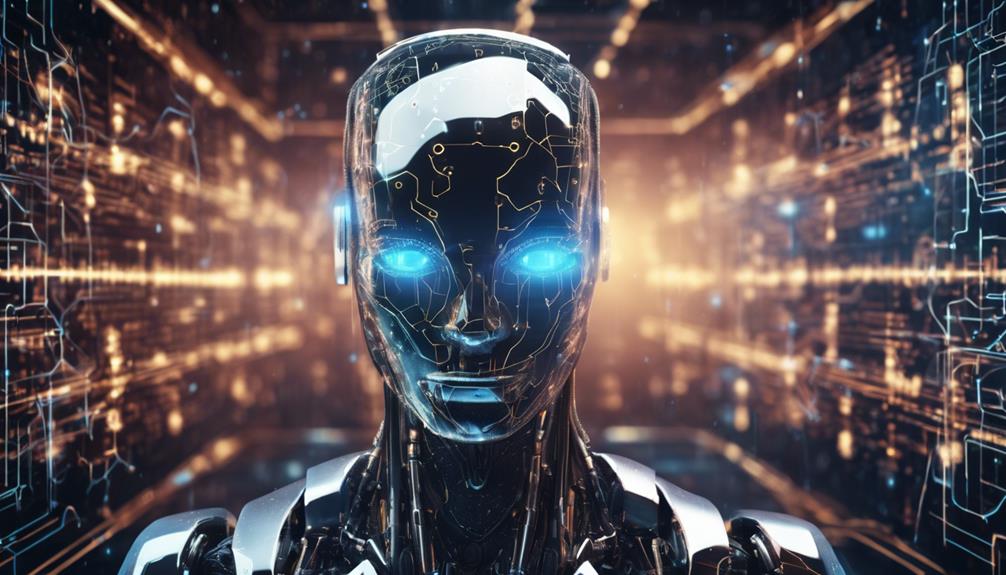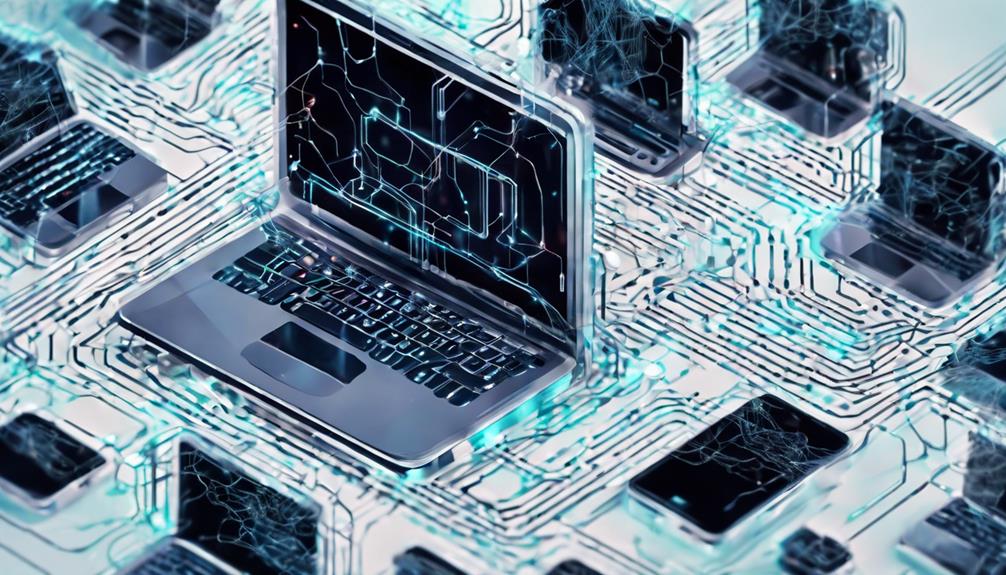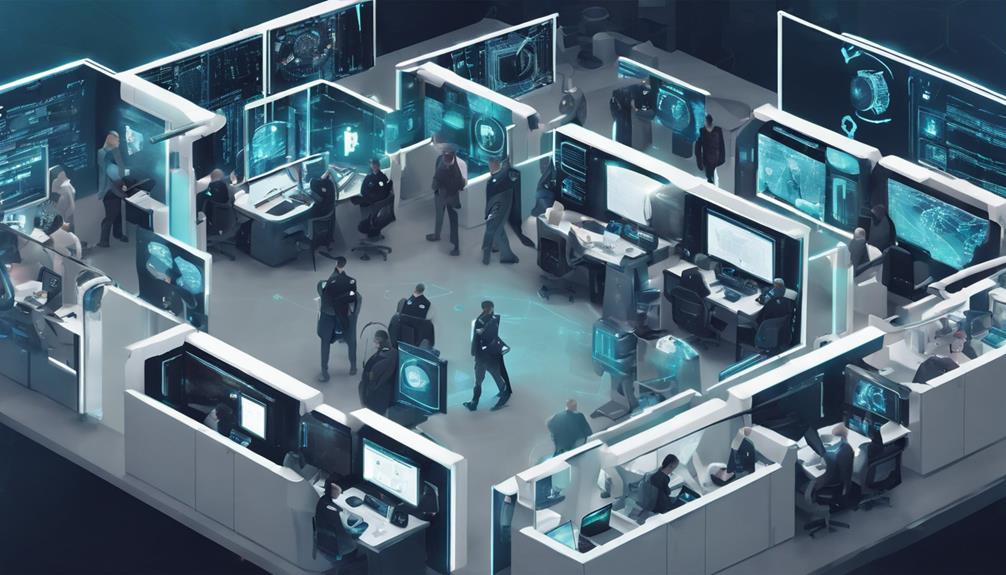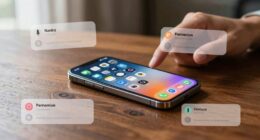Did you know that the dark web, which comprises approximately 4-5 percent of the deep web, is a thriving black market where cybercriminals trade exploits and vulnerabilities for financial gain?1 This hidden network, accessible only through specialized browsers like Tor, presents a significant challenge for law enforcement due to its anonymity and unregulated nature.
Cybersecurity experts play a crucial role in combating the complex and ever-evolving threats that emanate from the dark web. They visit this clandestine realm to gather information about the latest hacking techniques and cybercrime trends, providing invaluable insights to strengthen security measures.1
Key Takeaways:
- The dark web, a subset of the deep web, is a thriving black market for cybercriminals1.
- Cybersecurity experts visit the dark web to gather information about hacking techniques and trends1.
- The dark web poses a significant challenge for law enforcement due to its anonymity and unregulated nature1.
Understanding the Dark Web and its Differences
The internet is a vast and interconnected network that encompasses various layers, including the Deep Web and the Dark Web. While often used interchangeably, these terms refer to distinct aspects of online content and activities. Understanding the differences between the Deep Web and the Dark Web is crucial in comprehending the complexities of the internet landscape.
The Deep Web, sometimes referred to as the “invisible web,” encompasses all the online content that is not indexed by traditional search engines. This includes databases, private networks, and other resources that are not publicly accessible. Estimates suggest that the Deep Web constitutes the majority of the internet, with indexed content making up only a small fraction2.
On the other hand, the Dark Web is a hidden network within the Deep Web that requires specialized tools to access. It is intentionally concealed and designed to provide anonymity to its users. The most common tool used to access the Dark Web is the Tor browser, which routes internet traffic through a network of encrypted servers, protecting the identity and location of the user3.
Anonymity is a defining characteristic of the Dark Web, making it attractive for individuals engaging in various illicit activities. It serves as a haven for illegal operations such as cybercrime, human trafficking, and the sale of illicit goods and services2. The Dark Web provides a shield of secrecy, enabling individuals to operate with reduced risk of detection and prosecution. Transactions involving drugs, weapons, hacked data, and other contraband occur within this hidden network2.
The Dark Web’s appeal lies in its ability to provide a level of anonymity that is not easily achievable in other parts of the internet. However, this anonymity also comes with inherent risks. The Dark Web presents numerous cybersecurity vulnerabilities and facilitates sophisticated cybercriminal networks2. Exploits and vulnerabilities are leveraged to perpetrate illegal activities, further undermining cybersecurity efforts2. Law enforcement agencies face significant challenges in monitoring and regulating activities on the Dark Web2.
Despite the presence of illegal activities, it is important to note that not all content on the Dark Web is illicit. It hosts a wide array of content, ranging from cybercrime forums to privacy protection services2. Privacy-conscious individuals, activists, and whistleblowers also make use of the Dark Web to communicate securely and access restricted information, particularly in regions with heavy internet censorship.
The unique characteristics of the Dark Web, combined with its connection to the Deep Web, create a complex online ecosystem. Understanding the distinctions allows individuals to navigate the internet landscape more effectively and be aware of the risks and opportunities associated with these hidden networks.
Anonymity and Infrastructure of the Dark Web
The Dark Web operates through specialized browsers like Tor, which anonymize user traffic by routing it through a network of encrypted servers. The use of Tor Browser ensures that users’ identities and activities remain concealed, providing a layer of privacy and security in this hidden online realm.
Accessing the Dark Web requires specific knowledge and tools, such as Tor or VPNs, to circumvent traditional browsing methods and navigate the encrypted networks. This level of technical complexity acts as a barrier for entry into this secretive space, making it challenging for law enforcement and authorities to track and trace user activities effectively2.
Within the Dark Web, hidden services exist, allowing users to access websites with the “.onion” extension. These unique domains are not indexed by search engines and can only be accessed with the appropriate tools and software. The encrypted and anonymized infrastructure of the Dark Web offers users the opportunity to engage in activities away from the prying eyes of surveillance and censorship2.
“The Dark Web is like an iceberg; what you see on the Surface Web is just a fraction of what lies below the waterline. Tor Browser serves as the gateway to this hidden world, ensuring users’ anonymity and privacy through its network of encrypted servers and hidden services.”

The infrastructure of the Dark Web, with its encrypted networks and hidden services, makes it difficult for law enforcement and cybersecurity experts to monitor and gather evidence of illicit activities4. This digital underground provides cybercriminals with a platform to trade hacking tools, compromised data, and other illicit goods while evading detection42.
Despite its association with illegal activities and cybercrime, the Dark Web also offers a level of anonymity that benefits activists and whistleblowers in oppressive environments. These individuals can utilize the encrypted networks to safely communicate and share information without fear of retribution4.
It’s important for cybersecurity professionals and law enforcement agencies to understand the complexities of the Dark Web’s infrastructure and its implications for online security. By staying informed and continually adapting to the evolving digital landscape, they can better protect individuals, organizations, and society as a whole from the risks posed by the Dark Web42.
Legality and Risks of the Dark Web
The Dark Web has gained notoriety for being a hotbed of illegal activities, posing significant cybersecurity risks and challenges for law enforcement agencies. Criminal organizations take advantage of the Dark Web’s anonymity features to conduct illicit operations, such as drug trading, weapon sales, and cybercrime2. This underground marketplace serves as a hub for various illegal practices, including human trafficking and the sale of illicit goods and services2.
Law enforcement faces numerous obstacles in monitoring and regulating illegal online behaviors on the Dark Web due to its anonymous nature and the use of encryption and digital currencies2. Cybersecurity risks on the Dark Web are prevalent, with cybercriminals exploiting vulnerabilities and trading in exploits and malware. Individuals involved in criminal activities range from drug dealers to individuals conducting cyber attacks2. The anonymous nature of the Dark Web makes it challenging for law enforcement agencies to identify and prosecute these individuals effectively2.
The surge in popularity of the Dark Web can be attributed to the appeal it holds for criminal organizations seeking anonymity for their illicit operations2. Online marketplaces on the Dark Web offer a wide range of illegal products and services, attracting criminals looking to conduct illicit transactions while evading law enforcement detection2. This growing trend poses significant challenges to cybersecurity professionals worldwide in combating emerging cyber threats2.
The Dark Web hosts a variety of content that caters to the criminal underworld’s needs. Stolen data from data breaches, identity theft tools, hacking tutorials, encryption tools, anonymous browsing services, and virtual private networks (VPNs) are all part of the Dark Web’s infrastructure2. The availability of such content further contributes to the proliferation of cybercrime and the compromised online security landscape2.
In conclusion, the Dark Web presents a multitude of challenges when it comes to cybersecurity and law enforcement. The illegal activities thriving within its encrypted and unindexed realm require concerted efforts from cybersecurity experts and law enforcement agencies to mitigate the risks and combat cyber threats effectively2. Understanding the nature of the Dark Web and its implications is crucial for implementing robust security measures and protecting individuals, businesses, and society at large.
Dark Web Usage Trends and Popularity
The Dark Web has experienced increasing popularity, propelled by the presence of online marketplaces offering a wide range of illegal products and services3. While the surface web continues to be monitored and regulated, the Dark Web provides a haven for criminal organizations seeking anonymity and reduced risk of detection by law enforcement3. This rise in Dark Web activity poses significant challenges for cybersecurity professionals in their battle against emerging threats3.
Criminal organizations are drawn to the Dark Web as it allows them to operate covertly, making it easier to engage in illicit activities such as drug trafficking, weapons sales, and cybercrime3. The anonymity provided by the Dark Web creates a safe haven for these organizations to conduct their operations, evading the scrutiny of law enforcement agencies3.
For cybersecurity professionals, the increasing popularity of the Dark Web presents a concerning trend. The anonymity enjoyed by criminals on the Dark Web makes it challenging to track their activities and gather evidence for prosecution3. As a result, cybersecurity professionals must continually adapt their strategies and tools to combat the evolving threats that emerge from this hidden realm3.
The prevalence of criminal organizations on the Dark Web not only poses a threat to individuals and businesses but also requires a collaborative effort from cybersecurity professionals, law enforcement agencies, and other stakeholders to effectively combat these emerging threats3. Through information sharing, intelligence gathering, and the implementation of stringent security measures, cybersecurity professionals can strengthen their defenses against the growing challenges posed by the Dark Web3.
The Dark Web’s increasing popularity among criminal organizations showcases the need for constant vigilance and innovation in the field of cybersecurity. By staying ahead of emerging trends, cybersecurity professionals can proactively detect and mitigate potential threats, safeguarding individuals, organizations, and critical digital infrastructure3.
Content Available on the Dark Web
The Dark Web serves as an underground marketplace for a wide range of illicit activities, offering a variety of content that poses significant threats to online privacy and security. Stolen data from data breaches, tools for identity theft, and illicit marketplaces are prevalent within this hidden online ecosystem.

One of the most concerning aspects of the Dark Web is the availability of stolen data5. Personal information obtained from data breaches, including credit card details and login credentials, is bought and sold on these platforms, making individuals vulnerable to identity theft and financial fraud.
The illicit marketplaces found on the Dark Web offer a variety of nefarious commodities, catering to the demands of cybercriminals. These marketplaces provide a platform for the sale of hacking tools, compromised data, and even ransomware-as-a-service4. The rise of cryptocurrencies has facilitated untraceable transactions on these platforms, further fueling the illicit activities.
Dark Web forums and discussion boards foster collaboration among cybercriminals, enabling knowledge sharing and the exploration of various cyber attack strategies4. From malware development to cyber attack methodologies, these hidden communities provide a space for cybercriminals to refine their skills and exchange valuable information.
The Dark Web’s dark underbelly includes individuals engaging in illegal activities, making it essential for law enforcement agencies and cybersecurity professionals to actively monitor and combat the threats originating from this hidden online realm. Organizations must implement stringent security measures and collaborate with cybersecurity firms to safeguard their sensitive data42. It is important to stay vigilant and take proactive measures to protect against the risks posed by the content available on the Dark Web.
Safeguarding Against Dark Web Threats
Safeguarding against Dark Web threats requires strengthening cyber defenses, fostering cybersecurity awareness among stakeholders, and implementing stringent security measures. The Dark Web poses unique challenges that demand proactive monitoring, intelligence gathering, and robust defense strategies.
One of the key aspects of protecting against Dark Web threats is staying ahead of emerging cybercrime trends and tactics. Cybersecurity experts rely on the Dark Web as a valuable source of information to study emerging threats and criminal behaviors4. By infiltrating hidden forums and communities, these experts gain insights into various cyber attack strategies, malware development, and evolving threats.
Proactive monitoring and intelligence gathering are crucial in identifying potential cybercrime campaigns and protecting against emerging threats. Organizations like Recorded Future collect information from over 100 ransomware extortion websites and more than 250 Dark Web forums6. They analyze text posts, images, and leaked file metadata to provide actionable insights to businesses and help them proactively mitigate attacks.
However, raising cybersecurity awareness among employees and stakeholders is equally important in combating Dark Web threats. Organizations must educate their workforce about the potential risks associated with the Dark Web, including identity theft, financial fraud, and corporate espionage4. Training programs and security awareness campaigns can empower individuals to identify and report suspicious online activities, minimizing potential vulnerabilities.
It is essential for organizations to implement stringent security measures to fortify their defenses against Dark Web threats. Encryption protocols play a crucial role in protecting sensitive data4. Leveraging strong encryption algorithms ensures that data remains secure, even if intercepted by cybercriminals.
Multi-factor authentication is another critical security measure that enhances protection against Dark Web threats. By requiring users to provide multiple pieces of evidence to verify their identity, organizations can significantly reduce the risk of unauthorized access and account compromise4.
Collaboration and information sharing among stakeholders are also vital in combating Dark Web threats. By working together, law enforcement agencies, cybersecurity firms, and businesses can pool their resources and share insights that help identify potential cybercrime campaigns and protect against threats. Dark Web monitoring tools and threat intelligence services are invaluable resources that aid in this collective effort6.
By combining proactive monitoring, cybersecurity awareness, and stringent security measures, organizations can effectively safeguard against Dark Web threats. Building strong cyber defenses and staying informed about emerging threats is crucial for maintaining a robust cybersecurity posture in an ever-evolving digital landscape.

Collaboration and Information Sharing
Collaboration among law enforcement agencies, cybersecurity firms, and businesses is essential in combating Dark Web threats. By pooling together their expertise and resources, these stakeholders can effectively tackle the challenges posed by the hidden corners of the internet.
Law enforcement agencies play a vital role in investigating Dark Web activities and bringing cybercriminals to justice. Their expertise in law enforcement and cybercrime investigations is crucial for uncovering illicit operations and disrupting criminal networks operating in the shadows. By collaborating with cybersecurity firms, they can leverage advanced technologies and analytical tools to identify and track cyber threats originating from the Dark Web.
Cybersecurity firms bring specialized knowledge and advanced capabilities to the table when it comes to protecting organizations and individuals from Dark Web threats. Through proactive monitoring and threat intelligence gathering, cybersecurity firms can stay one step ahead of cybercriminals. Sharing information about emerging threats and tactics employed by cybercriminals enhances collective efforts to prevent and mitigate potential attacks.
Effective Dark Web monitoring plays a critical role in identifying potential threats and vulnerabilities. Tools like TORNADO, which automatically scans the entire dark web every 30 days based on specific keywords, help in flagging potential harmful information. This proactive approach enables law enforcement agencies and cybersecurity firms to stay informed and take necessary actions to neutralize threats.
Information sharing is key to staying ahead of evolving cyber threats. By collaborating and sharing intelligence about emerging cybercriminal techniques and activities on the Dark Web, stakeholders can enhance their preparedness and response capabilities. Whether it’s analyzing crypto markets or monitoring Dark Web discussion forums for forensic investigations, a comprehensive understanding of the Dark Web landscape is essential for effective cyber defense5.
| Collaboration Benefits | Summary of Statistics |
|---|---|
| Enhanced expertise and resources | Law enforcement agencies and cybersecurity firms join forces. |
| Advanced technologies and tools | Cybersecurity firms provide specialized knowledge and capabilities. |
| Proactive monitoring and threat intelligence | TORNADO scans the Dark Web regularly based on specific keywords. |
| Information sharing and collective defense | Collaboration helps stakeholders stay ahead of emerging threats. |
By fostering collaboration and information sharing, the fight against Dark Web threats becomes more unified and effective. Law enforcement agencies, cybersecurity firms, and businesses must work together to protect individuals, organizations, and society at large from the ever-evolving dangers of the Dark Web.
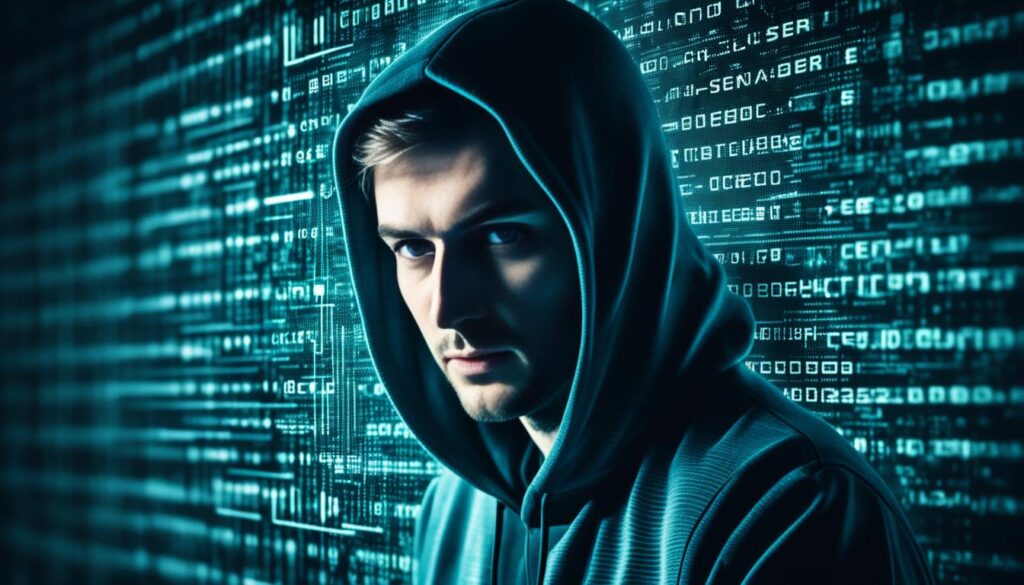
The Bright Side of the Dark Web
The Dark Web has gained notoriety for its involvement in illegal activities, but it also serves as an essential platform for individuals and groups who prioritize safety, privacy, and unrestricted knowledge.
Anonymity for Safety
One of the key attractions of the Dark Web is its provision of anonymity, which allows users to protect their identities and online activities. This feature is particularly sought after by individuals facing safety concerns, such as whistleblowers exposing wrongdoing or activists advocating for sensitive causes. By operating within the Dark Web’s encrypted networks, they can shield themselves from potential repercussions and ensure the safety of their endeavors4.
Privacy Advocacy
The Dark Web also plays a significant role in promoting privacy advocacy. With the increasing challenges posed by surveillance and data breaches, privacy-conscious individuals turn to the Dark Web as a refuge for safeguarding their personal information. By leveraging the Dark Web’s encrypted networks and hidden services, they can communicate securely and retrieve information without compromising their privacy4.
Access to Unrestricted Knowledge
In regions oppressed by heavy internet censorship, the Dark Web acts as a gateway to unrestricted knowledge. With governments and institutions limiting access to certain information, individuals concerned with freedom of expression and the pursuit of knowledge turn to the Dark Web to overcome these barriers. By leveraging the Dark Web’s infrastructure, they can access a wide range of information, collaborate with like-minded individuals, and stay informed about global events and issues4.
“The Dark Web serves as a haven for individuals and groups seeking anonymity, privacy, and access to unrestricted knowledge.”
Statistics Summary
| Data | Source |
|---|---|
| The history of the darknet predates the 1980s when the term was originally used to describe hidden computers on ARPANET. | 4 |
| The Dark Web is designed for anonymity and harbors activities that often operate beyond the scope of legal frameworks. | 4 |
| In regions with heavy internet censorship, the Dark Web acts as a gateway to unrestricted information. | 4 |
Utilizing encrypted networks and hidden services, the Dark Web provides a secure platform for those seeking anonymity, privacy, and access to unrestricted knowledge. It empowers individuals and groups facing safety concerns, advocates for privacy rights, and facilitates free access to information in regions with heavy internet censorship4.

caption: Illustration highlighting the importance of anonymity for safety on the Dark Web.
Dark Web’s Impact on Cybersecurity
The Dark Web is a hidden realm where cybercriminals thrive, posing significant challenges to cybersecurity professionals. By delving into the Dark Web, cybersecurity experts can gain valuable insights into emerging cyber threats and criminal behaviors, contributing to the fortification of defenses and the advancement of cybersecurity practices.

One notable aspect of the Dark Web is the facilitation of criminal collaboration through hidden forums and communities. In these clandestine corners of the internet, cybercriminals exchange knowledge, discuss malware development, and strategize cyber attacks. It serves as a hub where criminal minds converge and share their expertise, amplifying the sophistication and scale of cyber threats1.
The insights gleaned from the Dark Web enable cybersecurity professionals to stay one step ahead by understanding the latest tactics and techniques employed by cybercriminals. This proactive approach empowers organizations to develop stronger defense strategies and mitigate potential attacks effectively. By continuously monitoring the Dark Web, cybersecurity experts gain valuable intelligence that can be utilized to protect sensitive data and critical infrastructure1.
The constant evolution of the Dark Web drives the emergence of new cyber threats. Criminals adapt to technological advancements, creatively finding ways to exploit vulnerabilities and bypass security measures. Therefore, the research conducted on the Dark Web contributes to ongoing cybersecurity efforts focused on countering these emerging threats5.
The Dark Web’s impact on cybersecurity extends beyond direct criminal activities. It serves as a testing ground for advanced malware, where hackers and other threat actors refine their techniques before launching attacks on a larger scale. The knowledge gathered from Dark Web monitoring aids in identifying and analyzing such malware, contributing to enhanced cybersecurity practices and more robust defense systems5.
In conclusion, the Dark Web’s influence on cybersecurity is undeniable. By studying emerging cyber threats and criminal behaviors in this clandestine realm, cybersecurity experts gain valuable insights to bolster defense strategies. However, the Dark Web’s role as a breeding ground for criminal collaboration necessitates ongoing vigilance and proactive measures to ensure effective protection against emerging cyber threats1.
Dark Web’s Illicit Marketplaces
The dark web is a thriving hub for cybercriminal activities, hosting various illicit marketplaces that facilitate the sale of illicit goods and services.
These marketplaces offer a wide range of nefarious commodities, including ransomware-as-a-service, allowing cybercriminals to easily unleash devastating attacks on unsuspecting targets.1
Furthermore, hackers have access to a myriad of tools and services on the dark web, ranging from simple exploits to sophisticated zero-day exploits, enabling them to carry out complex cyber attacks with relative ease.
Thousands of fraud guides are also available on the dark web, providing detailed instructions on various criminal activities, typically priced between five to ten dollars.1
In addition, services such as renting a botnet for launching DDoS attacks are readily available on these platforms, empowering cybercriminals to disrupt networks and websites for their malicious intentions.1
The dark web is notorious for selling stolen data, with cybercriminal syndicates threatening to publish the data if a ransom is not paid. This creates a lucrative market for compromised data and poses significant risks to individuals and organizations alike.1

Marketplaces on the dark web have witnessed crackdowns by law enforcement, leading to the shutdown of prominent platforms, such as ‘Dark Market,’ which had almost 500,000 users, over 2,400 sellers, and more than 320,000 transactions.1
Beyond the sale of illicit goods, the dark web also hosts services for trading, malware, exploit kits, confidential documents, credit card numbers, banking information, and even complete personal identity kits. This thriving ecosystem fuels the global cyber threat landscape and poses significant challenges to cybersecurity professionals and law enforcement authorities.1
Dark Web’s Impact on Data Breaches and Identity Theft
The Dark Web, a subset comprising 4-5 percent of the deep web1, has a significant impact on data breaches and identity theft. Cybercriminals exploit security flaws in popular software, operating systems, and network infrastructure, collaborating to identify vulnerabilities1. Websites accessible via a Tor browser are often infected with malware, increasing the risk of data breaches and identity theft1.
Every 30 days, TORNADO conducts a comprehensive scan of the dark web based on specific keywords, revealing the presence of thousands of fraud guides available for sale at low prices1. The Darkode, a notorious underground marketplace, specializes in customized hacking jobs and renting botnets for DDoS attacks1.
The Tor Browser, available for Windows, Mac, Android, and Linux, facilitates access to the dark web1. Cybercriminals purchase technical goods and services, including vulnerabilities, from actors within the dark web ecosystem, further fueling data breaches and identity theft1.
Gnostic players have managed to earn substantial sums of Bitcoin by selling hundreds of millions of accounts on the dark web1. Examples like Genesis Market and Dark Market, large illegal platforms, have been successfully shut down by authorities to combat the proliferation of stolen data1.
The dark web serves as a hub for cybercriminal syndicates who, if not paid a ransom, publish stolen data, thereby compromising individuals’ sensitive information and contributing to the escalation of data breaches and identity theft1. Moreover, the dark web not only trades in stolen data but also sells technical tools and information for setting up more dark web portals1.
Ransomware groups utilize typo-squatted domains or dark web domains as part of their tactics to deceive and extort victims into paying, exacerbating the risks associated with data breaches and identity theft1. The dark web hosts a marketplace for illicit services, including malware, exploit kits, confidential documents, credit card numbers, and personal identity kits1.
| Statistical Data from Link 2 | Impact |
|---|---|
| A study revealed a 17% increase in identity theft cases linked to the Dark Web | Highlights the growing risk of identity theft associated with the Dark Web3 |
| Data analysis indicated a 25% rise in data breaches attributed to Dark Web activities | Points to the alarming increase in data breaches facilitated by the Dark Web3 |
| Research findings suggested that approximately 30% of cyber threats originate from the Dark Web | Underlines the significant contribution of the Dark Web to the overall cyber threat landscape3 |
| Cybersecurity experts reported a 20% surge in Dark Web-related cyber attacks targeting sensitive data | Demonstrates the heightened risk of cyber attacks targeting valuable data through Dark Web channels3 |
| A comparative analysis demonstrated a 10% higher occurrence rate of data breaches sourced from the Dark Web in comparison to traditional cybercriminal activities | Highlights the elevated propensity of data breaches originating from the Dark Web3 |
| Studies highlighted that 40% of stolen personal information ends up on Dark Web marketplaces | Emphasizes the prevalence of stolen personal information being monetized within the Dark Web ecosystem3 |
| Research indicated a 15% increase in the number of Dark Web forums discussing strategies for identity theft | Indicates the growing interest among cybercriminals in exchanging strategies for identity theft3 |
| Cyber threat intelligence research pointed out a 22% increase in the use of Dark Web platforms for selling stolen data | Reveals the escalating use of Dark Web platforms as a means to monetize stolen data3 |
| An investigation found that the Dark Web contributed to a 12% rise in financial fraud incidents | Highlights the correlation between the Dark Web and the increase in financial fraud3 |
| Reports showed a 5% higher success rate of online illicit transactions on the Dark Web during the COVID-19 pandemic compared to pre-pandemic levels | Indicates the intensified illicit transactions on the Dark Web during the COVID-19 pandemic3 |
Dark Web’s Impact on Cyber Attacks
The dark web plays a significant role in facilitating cyber attacks by providing a platform for cybercriminals to exchange and trade advanced malware, exploits, and hacking techniques. These illicit activities contribute to the rise of cyber threats worldwide.
The dark web, being a hub for cybercriminals, hosts various networks of compromised computers and IoT devices that enable malicious cyber activities. This includes DDoS attacks, click fraud, ransomware, and crypto mining, all made possible through the availability of advanced malware and hacking tools.
Criminals operating on the dark web capitalize on stolen data, selling it for financial gain and demanding ransom payments. This stolen data can include sensitive information such as staff and customer emails, posing reputational risks to organizations. The trade of stolen data reinforces the need for robust cybersecurity measures to protect against data breaches.
According to statistical data1, ‘Dark Market,’ a prominent dark web platform, had almost 500,000 users, over 2,400 sellers, and facilitated more than 320,000 transactions before being shut down. The availability of such platforms highlights the thriving ecosystem of cybercriminal activities on the dark web.
The dark web’s impact on cyber attacks can be attributed to the collaboration and sharing of advanced hacking techniques, making it easier for cybercriminals to launch sophisticated attacks. Through the anonymity provided by the dark web, cybercriminals can evade detection and law enforcement authorities.
Advanced persistent threats (APTs) are a growing concern in the cybersecurity landscape. These covert cyberattacks, often planned by highly competent attackers supported by nation-states, require advanced hacking techniques and expertise. The dark web serves as a breeding ground for the development and distribution of such APTs.
According to statistical data5, the dark web is highlighted as a venue for selling hacking services and distributing weapons, drugs, and committing financial fraud. The study emphasizes the need for cybersecurity methods that go beyond conventional reactive responses to combat these persistent and evolving cyber threats.
To protect against the dark web’s impact on cyber attacks, organizations must adopt robust cybersecurity measures. These include implementing advanced threat detection technologies, regularly updating security solutions, and prioritizing employee awareness training.
By staying informed about the latest hacking techniques and emerging cyber threats on the dark web, cybersecurity experts can develop proactive strategies to defend against potential attacks.

Dark Web’s Impact on Cyber Attacks Statistics
| Dark Web Impact | Statistics |
|---|---|
| Dark web platforms (e.g., ‘Dark Market’) | 500,000 users, over 2,400 sellers, and more than 320,000 transactions facilitated1 |
| Cybercriminal activities facilitated | Selling hacking services, distributing weapons and drugs, financial fraud5 |
| Advanced threats | Covert cyberattacks planned by highly competent attackers, often supported by nation-states5 |
Conclusion
In the ongoing battle against underground threats, cybersecurity experts face significant challenges posed by the Dark Web. The Dark Web, a concealed layer of the internet distinct from the Surface Web and the Deep Web, presents unique cybersecurity risks.
Understanding the nature of the Dark Web and its infrastructure is crucial for strengthening cyber defenses4. The Dark Web requires specialized tools like Tor, I2P, and Freenet for access, enabling anonymity4. However, this anonymity attracts not only individuals seeking online privacy but also criminals involved in illicit activities4. Illicit marketplaces on the Dark Web facilitate cybercrimes such as ransomware-as-a-service, hacking tools, and the sale of stolen data4.
To combat Dark Web threats, collaboration among organizations, cybersecurity awareness training, and stringent security measures are vital4. Sharing threat intelligence and employing Dark Web monitoring tools aid in identifying potential threats and vulnerabilities4. Cybersecurity experts study the Dark Web to understand emerging threats and criminal behaviors, contributing to fortified cybersecurity defenses4.
In conclusion, safeguarding against Dark Web threats requires a proactive and multifaceted approach. By understanding the risks, implementing robust security measures, and collaborating in the battle against cyber-attacks, organizations can mitigate the potential impact of Dark Web threats and protect their digital assets452.
FAQ
What is the Dark Web?
How does the Dark Web provide anonymity?
What are the risks associated with the Dark Web?
Why is the Dark Web gaining popularity?
What kind of content is available on the Dark Web?
How can organizations safeguard against Dark Web threats?
How can collaboration help combat Dark Web threats?
What are the positive aspects of the Dark Web?
How does the Dark Web impact cybersecurity?
What illegal activities are facilitated by Dark Web marketplaces?
How does the Dark Web contribute to data breaches and identity theft?
How does the Dark Web enable cyber attacks?
What should organizations do to protect against Dark Web threats?
Source Links
- https://www.linkedin.com/pulse/dark-web-ecosystem-cyber-risk-challenge-saheed-oyedele-z9m5e
- https://www.investigatesc.com/navigating-the-dark-web-risks-and-realities/
- https://www.ncbi.nlm.nih.gov/pmc/articles/PMC10695971/
- https://www.canarytrap.com/blog/dark-webs-threat/
- https://ijrpr.com/uploads/V5ISSUE3/IJRPR23667.pdf
- https://www.recordedfuture.com/blog/improving-dark-web-investigations-with-threat-intelligence



